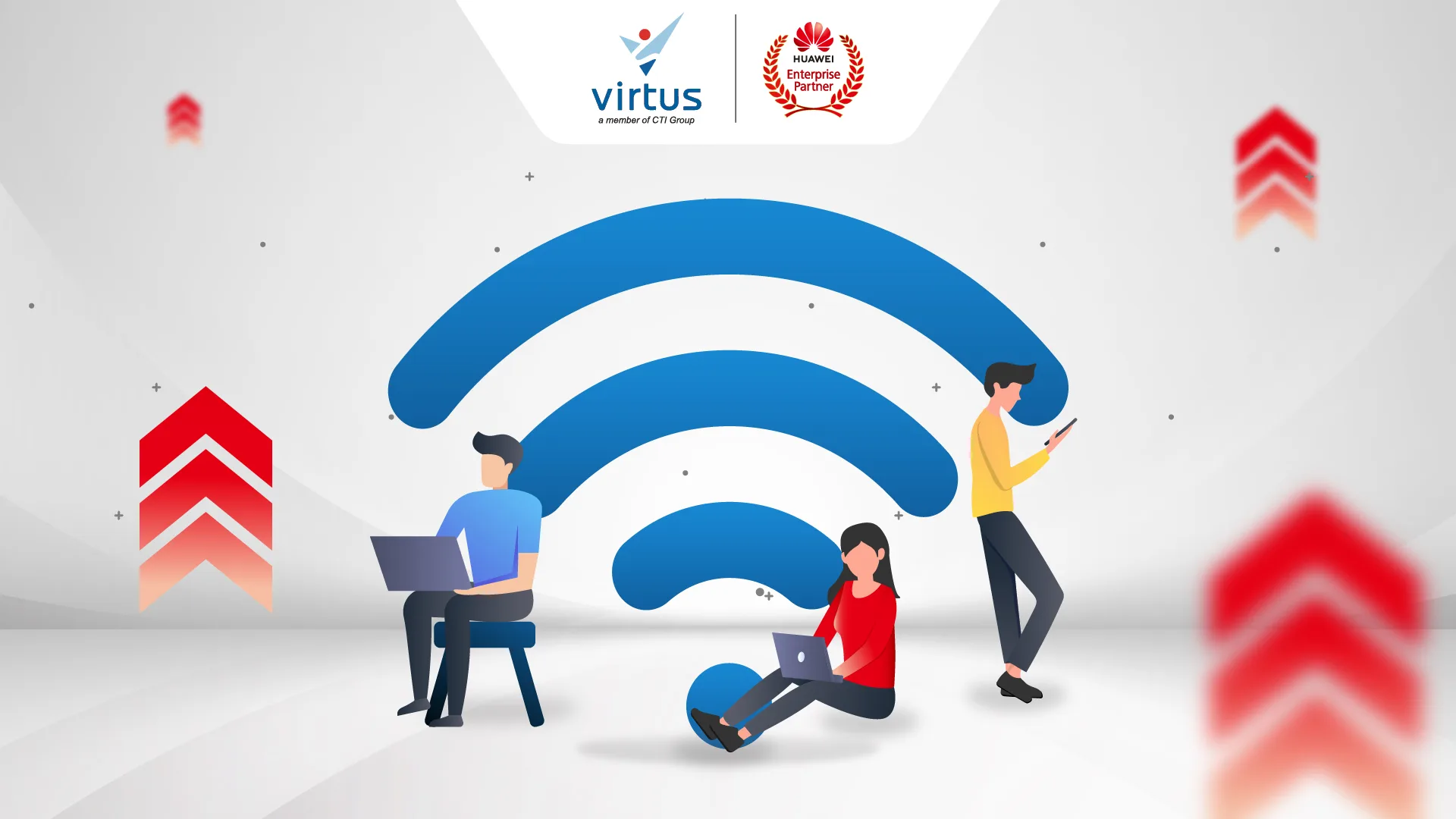After the rollout of Wi-Fi 6, the arrival of Wi-Fi 7 signals a new era in wireless connectivity. Far from being just another incremental upgrade, it’s seen as a disruptive leap designed to handle the growing demands of enterprises in the age of AI, big data, and latency-sensitive real-time applications.
But here’s the big question: how different is it really from Wi-Fi 6?
What is Wi-Fi 7?
Wi-Fi 7, officially known as IEEE 802.11be, is the newest generation of wireless LAN standards. It’s built for one clear purpose: delivering extremely high throughput with greater efficiency and stability. With support for 320 MHz channels, advanced 4K-QAM modulation, and Multi-Link Operation (MLO), Wi-Fi 7 allows devices to connect across multiple bands simultaneously—reducing latency, increasing speed, and keeping networks steady even under heavy traffic.
Wi-Fi 7 & Wi-Fi 6 Technical Differences
From a technical perspective, Wi-Fi 7 is more than a step forward—it’s a leap. Nearly every core element has been upgraded, from channel bandwidth to modulation and energy efficiency, positioning Wi-Fi 7 as the most advanced wireless standard available today.
| Aspect | Wi-Fi 7 | Wi-Fi 6 |
| Bandwidth | Up to 320 MHz, double the width for far greater data capacity | Up to 160 MHz, limited capacity |
| Modulation | 4K-QAM, denser data transmission for higher throughput | 1024-QAM, lower overall speed |
| Latency | Ultra-low with Multi-Link Operation (MLO), ideal for real-time workloads | Higher latency, no MLO support |
| MU-MIMO | 16×16, supports many more devices simultaneously with stable performance | 8×8, struggles in high device-density environments |
| Efisiensi Energi | Next-gen Target Wake Time (TWT), optimized for IoT devices | Basic TWT, less efficient |
| Spektrum | Adds 6 GHz band support, more stable and less interference | Limited to 2.4 GHz and 5 GHz, prone to congestion |
Wi-Fi 7 vs Wi-Fi 6 Performance in the Enterprise
In enterprise environments, success isn’t measured by speed alone. Stability, scalability, and the ability to handle thousands of simultaneous connections are equally critical. This is where Wi-Fi 7 sets itself apart from Wi-Fi 6, offering the consistency and future-proofing enterprises need to stay ahead.
| Aspek | Wi-Fi 7 | Wi-Fi 6 |
| Capacity | Handles thousands of IoT devices, sensors, and apps simultaneously | Performance drops quickly under high device loads |
| Stability | Strong resistance to interference, stable even in heavy traffic | More prone to disruptions in crowded environments |
| Latency | Ultra-low, perfect for AR/VR, telemedicine, and real-time trading | Higher latency, unsuitable for critical real-time use |
| Future-Proofing | Infrastructure ready to support enterprise needs for the next 5–10 years | Less aligned with long-term enterprise roadmaps |
| Energy Efficiency | Advanced TWT for better IoT power savings | Limited efficiency, higher energy consumption |
Spectrum and Regulation: Unlocking Wi-Fi 7 in Indonesia
Wi-Fi 7 technically arrived in Indonesia as early as 2024, but its performance was capped. The reason: the 6 GHz spectrum—the backbone of Wi-Fi 7—had not yet been released for public use. This meant devices were limited to the crowded 2.4 GHz and 5 GHz bands, unable to fully leverage Wi-Fi 7’s strengths such as 320 MHz bandwidth and ultra-low latency.
That changed in February 2025, when the government passed Regulation No. 2/2025, officially opening the 6 GHz spectrum (5925–6425 MHz) for Radio Local Area Network (RLAN) use. This marked a turning point: enterprises in Indonesia can now unlock the full potential of Wi-Fi 7 with global-standard stability, capacity, and efficiency.
With spectrum unlocked, the question shifts from when Wi-Fi 7 will take off, to who is ready to deliver enterprise-grade solutions.
Huawei: Leading the Way in Enterprise Wi-Fi 7
Huawei is no newcomer in enterprise networking. With decades of global leadership in wireless innovation, the company is bringing Wi-Fi 7 not just as a consumer technology, but as the first enterprise-grade Wi-Fi 7 solution in Indonesia. That means stronger security, better stability, and higher scalability designed specifically for enterprise needs.
Key Features of Huawei Wi-Fi 7
Huawei equips Wi-Fi 7 with cutting-edge innovations that go beyond raw speed. These features make it smarter, more reliable, and purpose-built for modern enterprise environments.
AI-Powered RF Optimization
Automatically selects the best channels, reduces interference, and ensures smooth connections—even in dense traffic environments.
Cloud Management Integration
Centralized management through iMaster NCE and CloudCampus allows IT teams to monitor, configure, and troubleshoot networks more efficiently.
16×16 MU-MIMO for Massive Connectivity
Supports far more devices simultaneously without performance drops, ideal for IoT-heavy environments with sensors, cameras, and real-time applications.
4K-QAM for Heavy Applications
Advanced modulation enables faster, denser data transfers, powering workloads like real-time analytics, UHD video, and cloud-based collaboration.
End-to-End Ecosystem Integration
Huawei delivers more than just access points—its ecosystem integrates with cloud and security solutions, simplifying deployment while ensuring long-term scalability.
Case Study: Huawei Wi-Fi 7 at Shenzhen’s Smart Campus
Huawei and Welkin School in Shenzhen built an all-scenario smart campus powered by Wi-Fi 7. The deployment spanned classrooms, corridors, labs, and outdoor spaces—delivering seamless connectivity across the entire campus.
With Wi-Fi 7, hundreds of devices—including laptops, tablets, sensors, cameras, and cloud apps—ran simultaneously without disruption. The result: more interactive teaching, smoother real-time collaboration, and more efficient campus management. This project highlights Wi-Fi 7’s transformative power not only in education, but also in large-scale enterprise environments.
Huawei x Virtus: A New Era of Connectivity
Technology adoption is only as strong as the ecosystem supporting it. In Indonesia, Huawei partners with Virtus Technology Indonesia (VTI)—to bring enterprise-grade Wi-Fi 7 to life.
This collaboration combines Huawei’s world-class innovation with VTI’s local expertise, covering deployment, integration, and after-sales support. Together, they ensure enterprises can transition to Wi-Fi 7 with confidence, efficiency, and future-readiness.
Build the Enterprise Network of Tomorrow with Virtus
As part of CTI Group, Virtus Technology Indonesia (VTI) together with Huawei is helping enterprises build next-generation Wi-Fi 7 infrastructure that’s faster, more stable, and more secure. With Huawei’s end-to-end ecosystem, businesses can tackle today’s connectivity challenges while preparing for the future.
Get in touch with Virtus today to discover how Huawei Wi-Fi 7 can accelerate digital transformation, improve efficiency, and take your enterprise to the next level.
Author: Danurdhara Suluh Prasasta
CTI Group Content Writer

